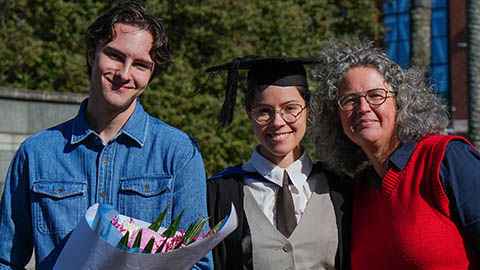From seabirds to crime scenes, Anika's scientific odyssey
15 May 2025
Masters graduate Anika Correll Trnka is a genetic sleuth.

From seabirds to crime scenes is quite a switch but Anika Correll Trnka is now proudly graduating with a Master of Forensic Science.
“It was definitely a challenge,” Anika admits with a smile. “I came into the degree with very little lab experience, so it was a steep learning curve. But I learned so much.”
Molecular and statistical methods for analysing mixed body fluids were the research focus for her masters. In her earlier Bachelor of Science (Honours) degree, Anika honed in on the New Zealand storm petrel, analysing the population of a bird deemed extinct until a sighting in 2003.
But the transition wasn’t as jarring as it sounds.
“I was using the same bioinformatics tools, just in a completely different context,” she explains. “It was exciting to apply those skills in a new way.”
Now 24, Anika was born in Fiji during a coup in August 2000 and spent her early years in the US (hence the American accent) before the move to New Zealand.
She’s the first in her family to venture into biology and forensic science – though with an academic mum, University of Auckland anthropology Professor Susanna Trnka, and a programmer dad, John Correll, it’s easy to see where the scientific and analytical genes come from.
There’s no one path into forensics – people come from all sorts of scientific backgrounds. That’s what makes it such a fun and collaborative field
Her masters research hinged around a common scenario where a mix of body fluids are identified at a crime scene. A stain may be identified as blood and saliva from two individuals, but it can be difficult to know who’s the source of the blood and who’s the source of the saliva.
“My project followed in the footsteps of international research looking at using RNA to help bridge that gap, associating a body fluid and a DNA profile,” says Anika. “The research had promising results but needs a lot of further development and validation to ever be used in a crime scene setting.”
These days, Anika works in Auckland as a data analyst at ESR – the Institute of Environmental Science and Research – supporting software developed by ESR and Forensic Science South Australia for forensic labs around the world, including the FBI, to untangle complex DNA mixtures. She also contributes to product development – a field she’s eager to dive deeper into.
Outside of work, Anika finds balance in playing classical piano and hiking, two passions that keep her grounded.
Looking back, she’s grateful for the support of her supervisors, Professor SallyAnn Harbison and Stephanie Opperman, as well as her family and friends. What advice would she give to students considering forensic science?
“It’s a tough degree, no doubt,” she says. “But it opens so many doors. There’s no one path into forensics – people come from all sorts of scientific backgrounds. That’s what makes it such a fun and collaborative field.
Media contact
Paul Panckhurst | science media adviser
M: 022 032 8475
E: paul.panckhurst@auckland.ac.nz